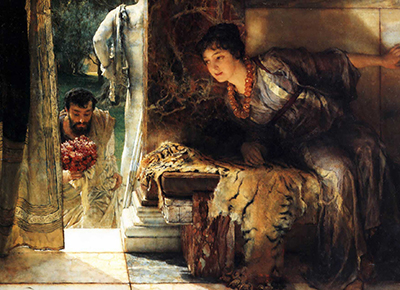On this magnificent paintwork, Lawrence Alma-Tadema portrays a beautiful woman sitting on the skin of a tiger and keenly following the footsteps of a bearded man as he approaches. He is carrying a bouquet of flowers, ostensibly for her.
Here, some quotas suggest that Alma-Tadema was portraying the scene and general mood of women whose men served the Emperor overseas, and had returned home. At the door, halfway blocked by the hanging curtain, is also the half back view of a nude male statue. Visibly beyond the door is a landscape that spans out. Welcome Footsteps in one of the many paintings that were inspired by his honeymoon visit to Italy with his first wife, French-born Marie-Pauline. He then brings out the Roman history to life depicting daily life in Rome and other places like Pompeii and Naples. The characters in this portrait depict a cheerful and romantic scene of ordinary but seemingly well-off citizens. They are quite life-like and real.
This mesmerising piece of art is an outcome of a well thought-out theme as well as great talent that had been carefully nurtured. Alma-Tadema ignored the then traditional technique of adding highlights over a dark canvas background to the opposite; painting dark hues onto white canvas. His palette listed eleven colours with two of them being supplementary. In essence, he used materials and techniques that were available in the nineteenth century to bring out this paintwork. A plain woven canvas fabric was a definite support material picked up as it was ideal for oil paintwork. Here, oil paints were definitely the most ideal medium to bring out the best in this portrait.
His mother, Hinke Dirks Brouwer, had a liking for art and she influenced his love for art at an early age. He went on to teach his half-brothers after being hired by a local drawing master. At the end of the training course, he was picked up to assist Louis Jan de Taeye who had been his role model and tutor. He, De Taeye, later inspired and influenced his love for Merovingian themes which he delightfully depicted until the mid-1860. He thus became known for accurately illustrating historical occurrences. In 1866, his first collection was commissioned by Ernest Gambart. Three of these were put up for a show in London. In 1935, Welcome Footsteps and other pieces of art, replicas, clothing and other personal belongings were given to the Fries Museum, in Leeuwarden, the Netherlands, as a gift from his daughter Laurence.




